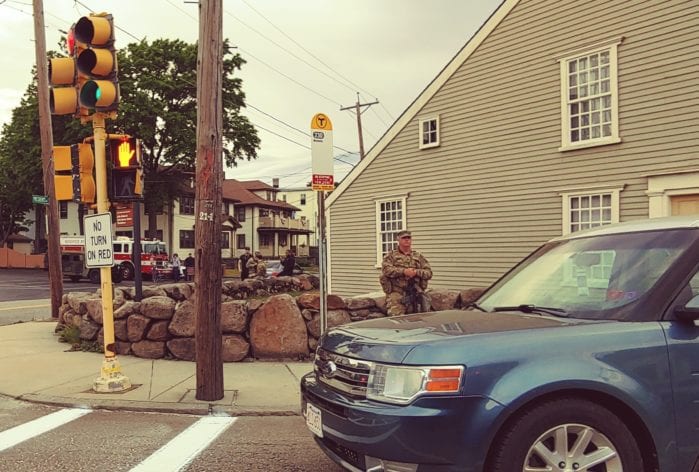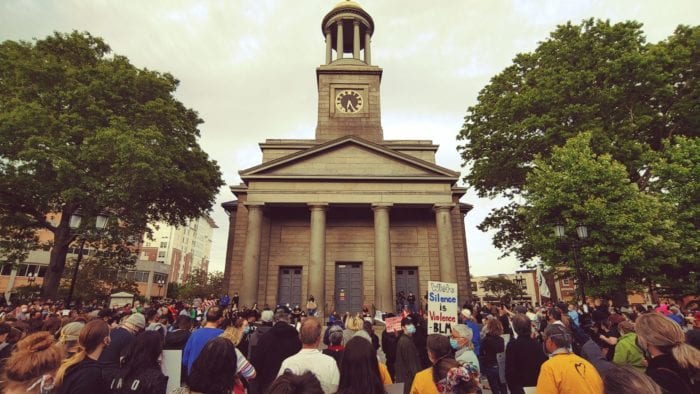
Mass spends millions every year replenishing its weapons stockpiles, as do municipal police agencies. In almost every instance, there is little to no oversight.
If I could spiritually channel founding fathers and interpret current events as if Thomas Jefferson himself was guiding my tongue, throat, and tonsils, I would have cashed in big by now as a righteous and monocled conservative pundit. Summoning such troubled souls is tricky business, for sure, but I saw something on Tuesday that nevertheless inspired me to invoke John Adams, who I surmise would have been dismayed to see armed national guardsmen posted by the house where he drafted the US Constitution. It’s nearly two-and-a-half centuries later, and racial tensions still roil the nation.
However the second president would have felt, from where I was standing, it’s horrible to witness such a landmark geared for wars instead of tours.
In the past two weeks, as protests have erupted nationwide in response to the killing of George Floyd by a Minneapolis cop with a history of violence, it’s been understandable that much of the public’s attention has been focused on the marches. After spending an afternoon reading about how President Trump may torch the Constitution in order to further fan the flames while police everywhere are deploying their deadly tools on rabble rousers and peaceful demonstrators alike, though, the image of those guardsmen standing with their rifles outside of the Adams home reinforced concerns I have had for years—we’re living at the mercy of an unhinged pack of alphas equipped with infinite arsenals funded by taxpayers, and despite constitutional ideals and balances that are supposed to be in place, there doesn’t appear to be anybody willing or able to keep them in check.

I believe that worry is at the heart of these protests, and is part of what’s keeping them raging night after night, even expanding to the ’burbs and smaller cities across Mass and elsewhere. As many have rhetorically asked in some way or another these past couple of days: When will it end? How will it end? I wish I had an answer, but the only thing I’m sure of right now is that elected officials—from town councils all the way up to the governor’s office—fueled and allowed for this foul predicament to foment. Their cozy relationships with six-figure earning cops who rarely face consequences for dangerous actions have got us to this point, and their failure to protect constituents should be remembered as people emerge from smoke and ashes and start asking why real changes have yet to be put in place. It’s because most politicians worship the police, or are at least afraid of losing their protection and support. Things are worse than you may realize, with only the Massachusetts Black and Latino Legislative Caucus and a handful of allies calling for legitimate reform, and some of them winning the open ire of Boston’s historically racist police union for calling cops out locally.
From 2018 to 2019, I led a team of reporters on a mission to impugn state contracts. We weren’t looking for any particular irregularities, but simply wanted to learn about how tax dollars are spent. Once we figured out how to read invoices and track expenditures, our researchers began spotting red flag after red flag in the books of law enforcement agencies. Our reporting was extensive, but in short we revealed an opaque police purchasing process that has scant oversight. As an example, we untangled a massive contract that enables police agencies to secure everything from “handguns,” to “silencers, tasers, tear gas, chemical munitions, pepperball launchers, dart guns, gas masks, and ballistic blankets.” Basically, all of the toys being deployed for crowd control this week.
Mass spends millions every year replenishing and bolstering its stockpiles, plus adding advanced equipment and technology. As do municipal police and other taxpayer-funded public safety outfits. In almost every instance, these purchases have little to no oversight beyond the procuring departments, and as a result sometimes go millions over budget with no recourse. Even in cases where contracts have been found by investigative authorities to have been secured through illegal transactions and fraudulent lobbying—in one case, Massachusetts State Police purchasing agents received kickbacks from a gun dealer in the form of firearms for their personal arsenals—the weapons bought remain in city, town, and state hands.
And when you’re sitting on all of that firepower, there’s a temptation to use it. Even though in these current protests, the targets are literally protesting the exact kind of force being exhibited, specifically how it is frequently used to cut black lives short. As one Mass national guardsman wrote on social media, “Fuck your riots … You’re all stupid and I can’t wait to shoot you tomorrow night.”

No one should be surprised about these antagonistic antics; this happens every time that overlapping agencies link for an orgy. As anybody who has read through reports about the police response to the shootout in Watertown which followed the bombing of the 2013 Boston Marathon may recall, in that situation, officers showed up from departments across the region, many self-dispatched, vigilante-style. An “After Action Report for the Response to the 2013 Boston Marathon Bombings,” which was coordinated by a “multi-disciplinary, multi-jurisdictional project management team consisting of key organizations involved in response activities, with the support of a private sector, third-party vendor,” found that “weapons discipline was lacking by the multitude of law enforcement officers in the field.”
Weapons discipline, you would think, is the most important thing for cops to get right. It’s perhaps all just too terrifying to conceive—even for me, and I’ve already feared for years that cops are prepping for a bloodbath. Massachusetts wasn’t always like this. Though I’ve had mostly harsh words for the Boston Police Department and other law enforcement agencies in my 15 years as a reporter in this state, I have also noted that Boston cops were typically far less likely to use violent crowd control techniques than police in places like Seattle, where I once had the displeasure of watching a pregnant woman and a senior citizen get showered in pepper spray.
But that’s where we seem to be right here, right now in the Bay State. In Boston, officers broke out what appeared to be tear gas on the Common Sunday evening, and showed up in mine-resistant ambush-protected street tanks. Shock and awe. Reports and images from Tuesday night in Dorchester were also troubling. Meanwhile, in Worcester, protesters reported getting hit with chalk pellets and smoke grenades, while Humvees lined the streets in Brockton as unruly protesters also clashed with cops in full riot gear.
And in Quincy, outside the humble lean-to where a founding document of the United States—purportedly rooted in liberty and justice but simultaneously protective of slavery—was outlined by candle and moonlight, soldiers wielding semi-automatics stood their ground, reminding us of who this country was designed to serve and protect.
A Queens, NY native who came to New England in 2004 to earn his MA in journalism at Boston University, Chris Faraone is the editor and co-publisher of DigBoston and a co-founder of the Boston Institute for Nonprofit Journalism. He has published several books including 99 Nights with the 99 Percent, and has written liner notes for hip-hop gods including Cypress Hill, Pete Rock, Nas, and various members of the Wu-Tang Clan.

